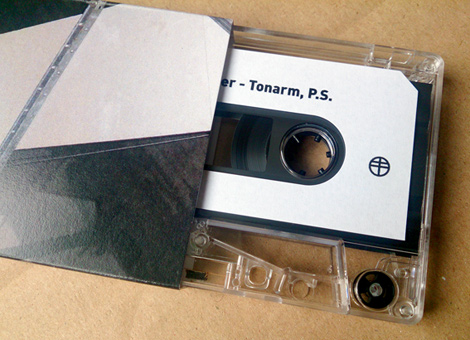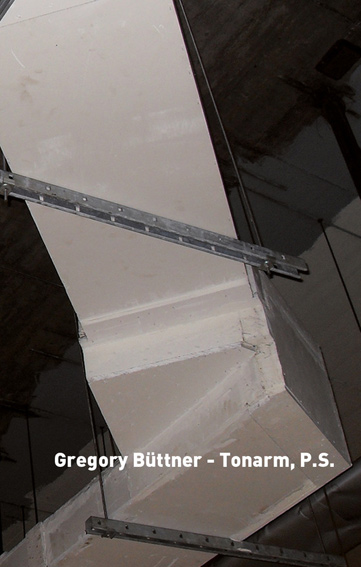CS, (37'52''), High-grade C45 chrome cassette, edition of 50 copies, cardboard folder
released by Fragment Factory, 2017
Side 1:
Tonarm p.s. riffelstange | 3:20
Tonarm p.s. draht+feder+aluschale+becken | 1:47
Tonarm p.s. draht+teedose+feder++ | 4:44
Tonarm p.s. draht+feder+schale | 1:48
Tonarm p.s. papier2 | 8:46
Side 2:
Tonarm p.s. alublech2 | 1:19
Tonarm p.s. plus | 5:38
Tonarm p.s. nadel | 1:07
Tonarm p.s. pappbecher+trichter | 8:20
For these pieces I played a vinyl record on a turntable using different objects like paper, metal and tin cans instead of the record needle. I recorded the sounds with a mic and composed, edited and mixed the pieces without additional digital processing.
Label description: After numerous CD releases since the early 2000's „Tonarm, P.S.“ is Büttner's first work for the cassette medium and perhaps also his most direct approach to the aesthetics of sound. By using different objects and materials to educe noises from record grooves, he draws on the synergy of materiality and acoustics to combine recorded sounds and the immediate sonic response to his actions. By this stripped-down technique, the sound itself seems to materialise and becomes experienceable in a very tangible manner.
all music by Gregory Büttner, 2013

CS sold out / or digital Bandcamp:
REVIEWS:
VITAL WEEKLY (Dutch)
In the past I already reviewed some of Gregory Büttner’s music, which operates both in the world of sound art as well as improvisation; the latter with people like Birgit Ulher, Simon Whetham and Rhodri Davies.
This is his first cassette release, and for this he built his own tone arm to amplify sounds from a record. We are not told which record. A very long time someone impressed me with very sharp fingernails amplifying a 7” with his fist being the speaker (if I recall well) and it’s certainly something you should try one day, obviously not using your most expensive record or use a needle instead of a fingernail. It gives the music a totally new outlook and that’s what fascinates Büttner as well I guess. The cover lists these objects, albeit in German, and there is a paper cup, tin can, feather, and tea box (and others).
The musical pieces Büttner creates with this are quite fascinating. It has very little to do with spinning records or objects in the way for instance Institut Für Feinmotorik did in the past. Only on very few occasions Büttner has these rotating sounds, but it sounds more like the rumble of acoustic objects with contact microphones with a very odd tonal quality to it. A bit field recordings like, I guess, in combination with object based sound art. Should you not know this has anything to do with tonearms, it might be very difficult to guess. That too made this into quite some interesting release.
I wonder: Does he do concerts with this and can we experience how it works live? That would be something to see one day.
Frans de Waard, vitalweekly.net/1097
BAD ALCHEMY (Germany)
Der Hamburger 1000füssler, längst auch improkompetent mit Birgit Ulher oder dem Stark Bewölkt Quartett, hat mit "Walze 1-8" oder, Seite an Seite mit Richard Chartier, mit "Tarpenbek Kontinuum", seinen Interpretationen von Asmus Tietchens, recht spezifische Klangspuren gelegt. Hier ging er turntablistisch zu Werk, indem er Vinylrillen abfurchte, allerdings nicht mit Tonabnehmernadel, sondern mit Riffelstange, Draht, Feder, Aluschale, Teedose, Papier, Pappbecher und dergl. Was sporadisch und kryptisch gerade mal ahnen lässt, dass sich hinter Schlurchen und Rauschen, Stöhnen und Wummern Gesang und Musik abspielen. Die sich der Wahrnehmbarkeit, mangels adäquater Technik, jedoch entziehen. Und einen dabei an die tastenden Anfänge der Phonographie zurück versetzen, zu den Schweinsborsten von Léon Scott, den Zinnfolien von Edison und der Berliner-Schrift. Als archaisch-naives, brutistisches Nadelton-Verfahren, das akustische Phänomene zeitigt, die an EVP, an mysteriöse Tonbandstimmen, erinnern. Allerdings sind Büttners taktilen Lauschangriffe auf das Vinyl weniger spiritistisch als, sogar im wörtlichen Sinn, archäologisch, indem sie Klänge ausgraben. Die mal als verborgene Schrift behandelt werden, die sich auf Papier abbilden soll. Oder als Information, die es in quasi verflüssigter Form mit Schalen, Dosen, Bechern aufzufangen gilt. Meist kommt dabei das Ausgrabungs- und Abspielwerkzeug mitsamt dem Drehmoment weit deutlicher zu Ohren als das in der Rille Verborgene. Der Loop wird zum rudimentären Groove, der Kontakt zum perkussiven Graffiti, das Medium zur Botschaft, die Tonabnahme zur Tongabe.
Rigo Dittman, BA 97, www.badalchemy.de
LE SON DU GRISLI (France)
Les dernières nouvelles reçues de Gregory Büttner provenaient de son propre label, 1000füssler : Wenn Uns Jemand Hört - Sag - Wir Haben Einfach Kurz Luft Geschnappt était un petit disque sur lequel l’intéressé faisait une belle musique de crépitements et du chant d’objets divers. Sur les labels Hideous Replica ou Herbal International, seul ou accompagné par la trompettiste Birgit Ulher, il avait plus tôt intéressé au son d’épreuves toujours différentes, qu’elles fussent électroacoustique ou concrète.
Sur cette cassette Fragment Factory (l’étiquette allemande lui assurant une sorte de « promotion »), Büttner compose sur des plaques tournantes qui nous renverront bientôt à l’oreille l'une de ses préoccupations : la rumeur qui rôde, sa lente déformation, sa disparition enfin. Maître d’un jeu de roulette unique sur lequel il balance combien de nouveaux objets, le musicien compose avec désinvolture. En seconde face, déclenchant une cascade de boucles et de silences, il impressionne même : car, chez Gregory Büttner, le grain de sable arrive toujours, qui grippe le ronron expérimental. Même prévenu, l’auditeur ne peut qu’y trouver son compte.
Guillaume Belhomme, 19. august 2018, grisli.canalblog.com
Top
